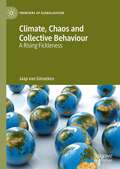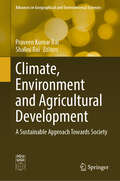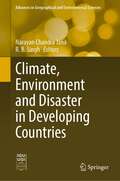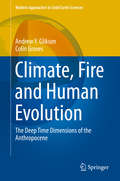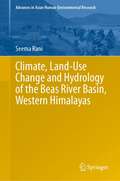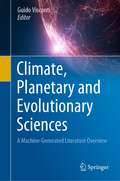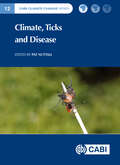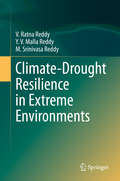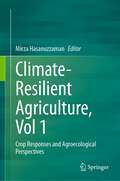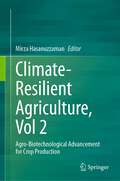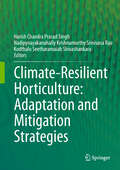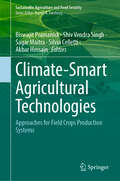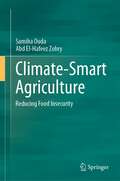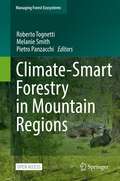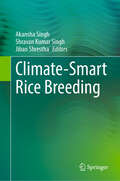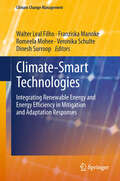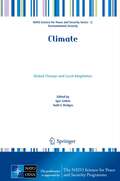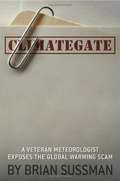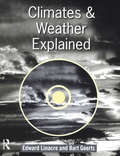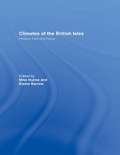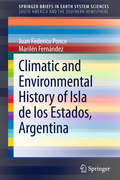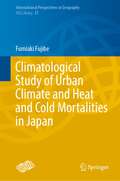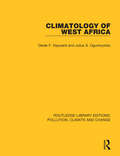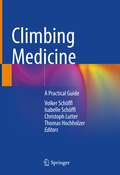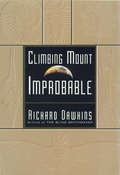- Table View
- List View
Climate, Chaos and Collective Behaviour: A Rising Fickleness (Frontiers of Globalization)
by Jaap van GinnekenThis book introduces principles of Chaos theory (and Complex Adaptive Systems) to social science, in a lively and elegant way. It applies it to the twin disciplines of mass psychology (under social psychology, mostly in Europe) and collective behavior sociology (mostly in North America) that deal with emergent psychosocial phenomena that lie outside conventional approaches. Each of the eleven chapters begins with a topical ‘case study’ section, on an issue related to climate change and collective behaviour, such as the ‘school strike’ by Swedish schoolgirl Greta Thunberg, the Hollywood movie The Day After Tomorrow, and more. This book aims to show that there are fundamental reasons why many phenomena cannot be easily ‘measured, predicted and controlled’, and thus we need to familiarize ourselves with alternative ways of thinking about them.
Climate, Environment and Agricultural Development: A Sustainable Approach Towards Society (Advances in Geographical and Environmental Sciences)
by Praveen Kumar Rai Shalini RaiThis book discusses an emerging context of climate change, environmental degradation, monitoring and management, agricultural vulnerability and its development and adaptation from local to global scale. The book also describes the research methodology in a simple and lucid way so that a researcher can adopt it in his/her field studies. Individual chapters are dedicated to different subjects such as the quantification of climate change impacts on environment; land use land cover; crops in controlled and field conditions; water resources; soil fertility, erosion and carbon sequestration; insects, pests, weeds, microbes and diseases; greenhouse gas emission assessment; regional vulnerability to climate change; and selection of crop. Researchers from around the world and from various fields explore these important topics in the book. The book is a valuable resource for environmentalists, geographers, economists, agronomists, biologists, agricultural scientist, climate modellers, policyanalysts, development agency staff, and graduate and postgraduate students.
Climate, Environment and Disaster in Developing Countries (Advances in Geographical and Environmental Sciences)
by R. B. Singh Narayan Chandra JanaThe world is currently experiencing changes in climate and environment that often lead to natural disasters. Nearly three million people worldwide may have been killed in the past 20 years by natural disasters. In total, 90% of the natural disasters and 95% of all disaster-related deaths occur in the developing countries. Recently such problems have accelerated due to LULC change, biodiversity degradation, increased tourism, urbanization and climate change. This book, consisting of 27 chapters, explores the topics of climate, environment and natural disasters in developing countries. It is essential to discuss these diverse issues in the field of geography as it encompasses interdisciplinary topics. The range of issues on national, regional and local dimensions is not only confined to geography but also concerned to other disciplines as well. Therefore, this book is a valuable source for scientists and researchers in allied fields such as climatology, disaster management, environmental science, hydrology, agriculture, and land use studies, among other areas. Furthermore, this book can be of immense help to the planners and decision-makers engaged in dealing with the problems of climate, environmental change and natural disasters in developing countries.
Climate, Fire and Human Evolution: The Deep Time Dimensions of the Anthropocene (Modern Approaches in Solid Earth Sciences #10)
by Colin Groves Andrew Y. GliksonThe book outlines principal milestones in the evolution of the atmosphere, oceans and biosphere during the last 4 million years in relation with the evolution from primates to the genus Homo - which uniquely mastered the ignition and transfer of fire. The advent of land plants since about 420 million years ago ensued in flammable carbon-rich biosphere interfaced with an oxygen-rich atmosphere. Born on a flammable Earth surface, under increasingly unstable climates descending from the warmer Pliocene into the deepest ice ages of the Pleistocene, human survival depended on both--biological adaptations and cultural evolution, mastering fire as a necessity. This allowed the genus to increase entropy in nature by orders of magnitude. Gathered around camp fires during long nights for hundreds of thousandth of years, captivated by the flickering life-like dance of the flames, humans developed imagination, insights, cravings, fears, premonitions of death and thereby aspiration for immortality, omniscience, omnipotence and the concept of god. Inherent in pantheism was the reverence of the Earth, its rocks and its living creatures, contrasted by the subsequent rise of monotheistic sky-god creeds which regard Earth as but a corridor to heaven. Once the climate stabilized in the early Holocene, since about ~7000 years-ago production of excess food by Neolithic civilization along the Great River Valleys has allowed human imagination and dreams to express themselves through the construction of monuments to immortality. Further to burning large part of the forests, the discovery of combustion and exhumation of carbon from the Earth's hundreds of millions of years-old fossil biospheres set the stage for an anthropogenic oxidation event, affecting an abrupt shift in state of the atmosphere-ocean-cryosphere system. The consequent ongoing extinction equals the past five great mass extinctions of species--constituting a geological event horizon in the history of planet Earth.
Climate, Land-Use Change and Hydrology of the Beas River Basin, Western Himalayas (Advances in Asian Human-Environmental Research)
by Seema RaniThere is a need of strengthening the global and local response to cope with the threat of climate change and adverse effects of rising anthropogenic activities in the mountain ecosystem. This book provides an up-to-date and comprehensive scientific and technical knowledge based on climate and land cover change impact assessment, adaptation and mitigation strategies in the Indian Himalayan watershed. The text updates the understanding scientific analysis to promote evidence-based policy formulation at regional and local levels. It can be used as reference materials with regards to climate and land cover change for those new learners interested in the mountainous region. This comprehensive book covers a wide range of potential research areas including climate change scenarios, science and its applications, adaptation to climate change-theory and assessment, water resources, agriculture, forest, biodiversity, and ecosystems, indigenous knowledge etc.
Climate, Planetary and Evolutionary Sciences: A Machine-Generated Literature Overview
by Guido ViscontiThis book presents the result of an innovative challenge, to create a systematic literature overview driven by machine-generated content. Questions and related keywords were prepared for the machine to query, discover, collate and structure by Artificial Intelligence (AI) clustering. The AI-based approach seemed especially suitable to provide an innovative perspective as the topics are indeed both complex, interdisciplinary and multidisciplinary, for example, climate, planetary and evolution sciences. Springer Nature has published much on these topics in its journals over the years, so the challenge was for the machine to identify the most relevant content and present it in a structured way that the reader would find useful. The automatically generated literature summaries in this book are intended as a springboard to further discoverability. They are particularly useful to readers with limited time, looking to learn more about the subject quickly and especially if they are new to the topics. Springer Nature seeks to support anyone who needs a fast and effective start in their content discovery journey, from the undergraduate student exploring interdisciplinary content, to Master- or PhD-thesis developing research questions, to the practitioner seeking support materials, this book can serve as an inspiration, to name a few examples. It is important to us as a publisher to make the advances in technology easily accessible to our authors and find new ways of AI-based author services that allow human-machine interaction to generate readable, usable, collated, research content.
Climate, Ticks and Disease (CABI Climate Change Series #18)
by Charles Hart Peter Cox A. Townsend Peterson Nicholas Johnson Wei Liu Jianhong Wu Richard Wall Domenico Otranto Agustín Estrada-Peña Jeremy Gray Abdul Jabbar Jolyon M. Medlock Sunit Kumar Singh Giovanni Benelli Peter Irwin Richard Bishop Xue Zhang Hao Li DeMar Taylor Deborah Hemming Saeed Alasmari Neil Alexander Abdelghafar Alkishe Reiko Arai Armanda Bastos Gervasio Henrique Bechara John Beier Joshua Benoit Dennis Bente Adrien Blisnick René Bødker Fernando Boinas Sarah Bonnet Nathalie Boulanger Alejandro Cabezas-Cruz Alexandre Rodrigues Caetano Cyril Caminade Jirí Cerny´ Roxanne Albertha Charles Ali Reza Chavshin Rosalind Cornforth Neil Coughlan Lauren Culler Milan Daniel Vlasta Danielova Mona Dehhaghi Maria Diuk-Wasser James P Duffy Olivier Duron Lars Eisen Rebecca Eisen Jana Elsterová Koray Ergünay Li-Qun Fang Natalia Fernández-Ruiz Erol Fikrig Serhii Filatov Durland Fish Janet Foley José De Fuente Roman Ganta Aysen Gargili Keles Robin Beat Gasser Abdul Ghafar Naftaly Githaka Lucy Gilbert Maryna Golovchenko Yuval Gottlieb Ernest Gould Libor Grubhoffer Gilles J. Guillemin Kayleigh M. Hansford John E. Healy Stephen Higgs Andrew Hoodless Yan-Jang S. Huang Bernard Hudson Chris Huntingford Esther Kanduma Sirri Kar Maria Kazimirova Neil Kaye Thomas C. Kelly Lene Jung Kjaer Agatha Onyemowo Kolo Eduard Korenberg Nina Król Chi-Chien Kuo Timothy J. Kurtti Xavier De Lamballerie Patrick A. Leighton L. Robbin Lindsay Geoffrey E. Lynn Ilya Maclean Ben J. Mans Maristela Martins de Camargo Karen D. McCoy Ulrike G. Munderloh Atle Mysterud Sukanya Narasimhan Anna Obiegala Dasiel Obregón Alvarez Dr Nick H. Ogden Mari H. Ogihara Stefan Vilges Oliveira Charlotte Oskam Kennan J. Oyen Neha Pandey Hamed Kazemi Panahi John H. Pettersson Martin Pfeffer L. Paul Phipps Heather J. Plumpton Tatjana Pustahija Ram Raghavan Ryan O.M Rego Annapaola Rizzoli Isobel Ronai Franz Rubel Natalie Rudenko Benjamin Ruiwen Rufus Sage Abdallah M. Samy Gustavo Seron Sanches Isabel Kinney Santos Marcello Otake Sato Megumi Sato Richard Schloeffel Seyyed Javad Seyyed-Zadeh Ladislav Šimo Daniel E. Sonenshine Morgan Sparey Frederic Stachurski Snorre Stuen Matias Pablo Szabó Mike Teglas Sam R. III Saravanan Thangamani Georgia Titcomb Attila J. Trájer Michael Turell Rika Umemiya-Shirafuji Dana L. Vanlandingham Laurence Vial Margarita Villar André B. Wilke G. R. Wint Zbigniew ZajacThis book brings together expert opinions from scientists to consider the evidence for climate change and its impacts on ticks and tick-borne infections. It considers what is meant by 'climate change', how effective climate models are in relation to ecosystems, and provides predictions for changes in climate at global, regional and local scales relevant for ticks and tick-borne infections. It examines changes to tick distribution and the evidence that climate change is responsible. The effect of climate on the physiology and behaviour of ticks is stressed, including potentially critical impacts on the tick microbiome. Given that the notoriety of ticks derives from pathogens they transmit, the book considers whether changes in climate affect vector capacity. Ticks transmit a remarkable range of micro- and macro-parasites many of which are pathogens of humans and domesticated animals. The intimacy between a tick-borne agent and a tick vector means that any impacts of climate on a tick vector will impact tick-borne pathogens. Most obviously, such impacts will be apparent as changes in disease incidence and prevalence. The evidence that climate change is affecting diseases caused by tick-borne pathogens is considered, along with the potential to make robust predictions of future events. This book contains: Expert opinions and predictions. Global coverage of trends in ticks and disease. In-depth examination of climate change and tick distribution links. This book is suitable for researchers and students studying zoology, biological sciences, medical entomology, animal health, veterinary medicine, epidemiology, parasitology, and climate change impacts; and for those concerned with public health planning or livestock management where ticks and tick-borne pathogens pose a threat.
Climate-Drought Resilience in Extreme Environments
by V. Ratna Reddy Y. V. Reddy M. Srinivasa ReddyThis book assesses the effectiveness of changes in watershed interventions in one of the most fragile resource regions of India. Specifically the chapters examine various watershed centred interventions and their implementation process. An evaluation of the livelihood impacts, including crop production on the communities, is discussed and an assessment of the drought and climate resilience of households in the context of watershed and related interventions, including institutions and capacity of the communities, is investigated. Lessons are drawn to further identify measures to strengthen and improvise interventions for enhanced climate-drought resilience in harsh environments.
Climate-Resilient Agriculture, Vol 1: Crop Responses and Agroecological Perspectives
by Mirza HasanuzzamanUnder ongoing climate change, natural and cultivated habitats of major food crops are being continuously disturbed. Such condition accelerates to impose stress effects like abiotic and biotic stressors. Drought, salinity, flood, cold, heat, heavy metals, metalloids, oxidants, irradiation etc. are important abiotic stresses; and diseases and infections caused by plant pathogens viz. fungal agents, bacteria and viruses are major biotic stresses. As a result, these harsh environments affect crop productivity and its biology in multiple complex paradigms. As stresses become the limiting factors for agricultural productivity and exert detrimental role on growth and yield of the crops, scientists and researchers are challenged to maintain global food security for a rising world population.This two-volume work highlights the fast-moving agricultural research on crop improvement through the stress mitigation strategies, with specific focuses on crop biology and their response to climatic instabilities. Together with "Climate Resilient Agriculture, Vol 2: Agro-Biotechnological Advancement for Crop Production", it covers a wide range of topics under environmental challenges, agronomy and agriculture processes, and biotechnological approaches, uniquely suitable for scientists, researchers and students working in the fields of agriculture, plant science, environmental biology and biotechnology.
Climate-Resilient Agriculture, Vol 2: Agro-Biotechnological Advancement for Crop Production
by Mirza HasanuzzamanUnder ongoing climate change, natural and cultivated habitats of major food crops are being continuously disturbed. Such condition accelerates to impose stress effects like abiotic and biotic stressors. Drought, salinity, flood, cold, heat, heavy metals, metalloids, oxidants, irradiation etc. are important abiotic stresses; and diseases and infections caused by plant pathogens viz. fungal agents, bacteria and viruses are major biotic stresses. As a result, these harsh environments affect crop productivity and its biology in multiple complex paradigms. As stresses become the limiting factors for agricultural productivity and exert detrimental role on growth and yield of the crops, scientists and researchers are challenged to maintain global food security for a rising world population.This two-volume work highlights the fast-moving agricultural research on crop improvement through the stress mitigation strategies, with specific focuses on crop biology and their response to climatic instabilities. Together with "Climate Resilient Agriculture, Vol 1: Crop Responses and Agroecological Perspectives", it covers a wide range of topics under environmental challenges, agronomy and agriculture processes, and biotechnological approaches, uniquely suitable for scientists, researchers and students working in the fields of agriculture, plant science, environmental biology and biotechnology.
Climate-Resilient Horticulture: Adaptation And Mitigation Strategies
by Nadipynayakanahally Krishnamurthy Rao Kodthalu Seetharamaiah Shivashankar Harish Chandra SinghClimate change, a global phenomenon, has attracted scientists to contribute in anticipatory research to mitigate adverse impacts, which are more important for horticulture, considering that the scenario is in the midst of revolution, reaching the production level of 250 million tonnes in India. Impacts of climate variability have, invariably, profound influence on production and quality. An understanding of the impacts and relevant adaptation strategies are of foremost importance to sustain the productivity and profitability of horticulture crops in the climate change scenario, which necessitates synthesis of current knowledge to develop strategies for adaptation and mitigation to achieve climate-resilient horticulture. The book Climate-resilient horticulture: adaptation and mitigation strategies addresses the effects of climate change on different horticultural crops and focuses on the adaptation strategies based on the scientific knowledge generated by the experts in different agro-climatic regions in India. Issues have been covered in various chapters to make this book a treasure of knowledge in horticulture vis-a-vis climate change. Some of the crops included in the book are apple, grapes, cashew, banana, litchi, mango, coconut, oil palm, potato, tomato, cucurbits and flowers. In addition to strategies to be adapted in these crops, various other important aspects like carbon sequestration, pests and diseases, and urban landscaping are also covered in the book. Information on climatic risks and adaptation options for resilience in horticultural crops and future strategies and information on pest and disease dynamics on horticultural crops in relation to climate change and available mitigation strategies have also been documented. The book is edited by Dr H P Singh, a visionary leader, and his colleagues, which will be highly valuable to research workers, students, policy planners and farmers to understand and checkmate the adverse effect of climate change, so as to convert weakness into opportunity.
Climate-Smart Agricultural Technologies: Approaches for Field Crops Production Systems (Sustainability Sciences in Asia and Africa)
by Akbar Hossain Biswajit Pramanick Shiv Vendra Singh Sagar Maitra Silvia CellettiThis book addresses the technologies that can be employed to tackle the challenges of global food security. Several recent studies have reported the significant impact of changing climate on the agricultural production, thus posing a challenge in achieving global food security. Thus, to mitigate these challenges there is an urgent need to develop approaches that may be helpful for the sustainability of food production. These approaches are based on three objectives: (i) sustainably increasing agricultural productivity to support equitable increases in farm incomes, food security, and development; (ii) adapting and building the resilience of food systems to climate change; and (iii), where possible, reducing GHGs emissions from agriculture. This book provides updated information for these climate-smart agricultural technologies that hold high potential to increase productivity, improve resilience, and provide efficient resource utilization. This book is a valuable resource for undergraduates, postgraduates, researchers, professors and policymakers in the field of agriculture, botany and agriculture extension functionaries.
Climate-Smart Agriculture: Reducing Food Insecurity
by Samiha Ouda Abd El-Hafeez ZohryThis book tackles the main feature of water-smart, soil-smart and crop-smart practices and their integration to sustainably enhance food production. The book includes some insights on the implications of using climate-smart practices in irrigated and rain-fed agriculture, and suggests approaches to eradicate the negative effects of water scarcity, climate variability and climate change. The book reviews the most important crops resilient to climate variability and their resistance to other biotic and abiotic stresses, and contains the existing practices in Egypt that achieved the three pillars of climate-smart agriculture
Climate-Smart Forestry in Mountain Regions (Managing Forest Ecosystems #40)
by Melanie Smith Roberto Tognetti Pietro PanzacchiThis open access book offers a cross-sectoral reference for both managers and scientists interested in climate-smart forestry, focusing on mountain regions. It provides a comprehensive analysis on forest issues, facilitating the implementation of climate objectives. This book includes structured summaries of each chapter.Funded by the EU’s Horizon 2020 programme, CLIMO has brought together scientists and experts in continental and regional focus assessments through a cross-sectoral approach, facilitating the implementation of climate objectives. CLIMO has provided scientific analysis on issues including criteria and indicators, growth dynamics, management prescriptions, long-term perspectives, monitoring technologies, economic impacts, and governance tools.
Climate-Smart Rice Breeding
by Akansha Singh Shravan Kumar Singh Jiban ShresthaThis book covers all aspects of smart-breeding technologies in creating novel crop architecture to meet future rice demand. Several advanced crop breeding technologies like, marker-assisted backcross breeding, marker-assisted recurrent selection, genomic assisted breeding, haplotype breeding and genome editing technologies have been introduced and employed for rice productivity improvement. Use of artificial intelligence and machine learning in crop phenotype prediction is paving the way for climate-smart breeding. Chapters in this volume cover all these relevant topics. The global rice demand is estimated to rise to 555 and 827.86 million tons in 2035 for milled rice and paddy, respectively. Enhancing high-nutrition rice production under the pressure of global climate change conditions is a hard task for breeders. Changing climatic scenarios and extreme weather conditions have increased the incidence of various biotic and abiotic stresses. Also, every degree rise in global mean temperature causes 3.2 % reduction in rice yield globally. This creates an urgent need for developing high-yielding rice varieties to tackle the aggravated issue of food security. This book is meant for scientists, professionals, researchers, and students working on enhancing rice production through advanced plant-breeding technologies.
Climate-Smart Technologies: Integrating Renewable Energy and Energy Efficiency in Mitigation and Adaptation Responses (Climate Change Management)
by Walter Leal Filho Romeela Mohee Dinesh Surroop Franziska Mannke Veronika SchulteThe book addresses the perceived need for a publication with looks at both, climate smart technologies and the integration of renewable energy and energy efficiency in mitigation and adaptation responses. Based on a set of papers submitted as part of the fifth on-line climate conference (CLIMATE 2012) and a major conference on renewable energy on island States held in Mauritius in 2012, the book provides a wealth of information on climate change strategies and the role of smart technologies. The book has been produced in the context of the project "Small Developing Island Renewable Energy Knowledge and Technology Transfer Network" (DIREKT), funded by the ACP Science and Technology Programme, an EU programme for cooperation between the European Union and the ACP region.
Climate: Global Change and Local Adaptation (NATO Science for Peace and Security Series C: Environmental Security)
by Igor Linkov Todd S. BridgesRising sea levels and altered weather patterns are expected to significantly alter coastal and inland environments for humans, infrastructure and ecosystems. Potential land-use changes and population increases, coupled with uncertain predictions for sea level rise and storm frequency/intensity represent a significant planning challenge. While efforts to mitigate climate change continue, plans must be made to adapt to the risks that climate change poses to humans, infrastructure, and ecosystems alike. This book addresses integrated environmental assessment and management as part of the nexus of climate change adaptation. Risk analysis has emerged as a useful approach to guide assessment, communication and management of security risks. However, with respect to climate change, an integrated, multi-criteria, multi-hazard, risk-informed decision framework is desirable for evaluating adaptation strategies. The papers in Part 1 summarize societal and political needs for climate change adaptation. Part 2 includes papers summarizing the state of the art in climate change adaptation. Three further parts cover: the process of change in coastal regions, in inland regions, and, finally, the potential challenges to homeland security for national governments. Each of these parts reviews achievements, identifies gaps in current knowledge, and suggests research priorities.
Climategate: A Veteran Meteorologist Exposes the Global Warming Scam
by Brian SussmanDangerous winds are blowing across America's culture today, creating an atmosphere of extreme anxiety. So why is the government making things worse? Former TV meteorologist turned talk show host Brian Sussman wondered that for years, and a decade's worth of investigation has yielded one of the most shocking stories of our time. In CLIMATEGATE, Sussman uncovers the following: * Communist founders Marx and Engels drafted the inspiration that drives today's environmentalist leaders. * Despite rigorous government-sponsored efforts to alter the record, past climate was significantly warmer than today. * Though only a minuscule sliver of earth's atmosphere, carbon dioxide is an essential nutrient for life and, when increased, can prove quite beneficial. * Barack Obama's presidency is a dream come true for those seeking to use the environment to destroy the United States. * Global warming is a convenient theory that is allowing venture capitalists, international bankers and multinational corporations to reap billions--and fellow travelers to imagine a one-world government. * Al Gore's Oscar-winning film should be considered a work of fiction. * Government agencies, elitist politicians and environmentalists are working together to block the expansion of both alternative and traditional energy resources. * The United Nation's policies have worked their way directly into U.S. environmental laws. * The recently leaked e-mails from Great Britain's climate center are further confirmation of a years-long, complex cover-up. * Updating the nation's energy grid is designed to bring Big Brother inside our home. In his book, CLIMATEGATE, Sussman combines his keen ability to readily explain complex scientific subjects with his astute political observations, driving home his conviction: the theory of man-made global warming is a fraud and many of the high-profile personalities fronting such claims are charlatans purposed to change society and make loads of cash.
Climates and Weather Explained: An Introduction From A Southern Perspective: Instructor's Resource Pack (includes Students' And Instructors' Cd-rom)
by Bart Geerts Edward LinacreClimates and Weather Explained is a comprehensive introduction to the study of the atmosphere integrating climatology and meteorology. Clear explanations of basic principles, concepts and processes are supported by a wealth of highly informative illustrations and a vast array of case studies demonstrating the relevance of weather and climate to everyday life. Focusing particularly on the Southern hemisphere the authors provide fresh insights into topical environmental concerns from global warming and natural hazards to sustainable global population. The textbook is supplemented by a unique interactive Student CD-ROM containing entirely additional material, for practical work and more advanced study. Closely related to each chapter of the book, the Student CD-ROM features: * Over 170 extra 'Notes', 40 illustrations and tables. * Multiple choice, self-assessment and practical exercises. * Extended glossary and key word searching * Hypertext presentation and extensive cross-referencing * A gallery of meteorological photographs in full colour A special Instructors' Resource Pack is also available containing an additional Instuctors'CD-ROM. For further information visit: website address here
Climates of the British Isles: Present, Past and Future
by Mike Hulme Elaine BarrowOur understanding of climate and its role in human affairs has changed markedly over recent years, as have climate observation systems and modelling capabilities. Reliance on recent weather statistics to provide a guide for future climate is no longer viable. Evidence of human-induced climate change has placed climate high on political and the media agendas. Climates of the British Isles provides a comprehensive account of what we know about climate and changing climates at the end of the twentieth century. Integrating the historical and geographical dimensions of climate, the crucial link between past and future climatic conditions is examined through the geographical lens of the British Isles. Climates of past ages are reconstructed and full descriptions of present climate are illustrated by a wealth of graphs, maps and images. Important climate data sets are provided. Marking the twenty-fifth anniversary of the internationally acclaimed Climatic Research Unit, this book distils much of the leading research of present and recent members of the unit and presents an authoritative, accessible view of climatic change and prospects for the next millenium and beyond.
Climatic and Environmental History of Isla de los Estados, Argentina (SpringerBriefs in Earth System Sciences #0)
by Juan Federico Ponce Marilén FernándezThis book is the result of ten years' of scientific research carried out by the authors on Isla de los Estados. The research includes their doctoral thesis and many published scientific papers related to the island. The book is divided into two principal parts. The first part covers different social and natural aspects of this remote island and includes chapters on the scientific and historical background, physiography with topographical and hydrographical descriptions, climate and oceanographic circulation, vegetation and geology (including stratigraphy, structural geology and geological history). The second part comprises a reconstruction of the paleoenvironmental, paleoclimatic and paleogeographic history of the island from the Last Glacial Maximum to the present, correlating with other paleoecological records from the southern part of Isla Grande de Tierra del Fuego and Patagonia. This second part also includes a geomorphological chapter with a characterization of the principal erosive glacial landforms on Isla de los Estados constructed by means of morphometric analysis, inventories, maps, paleogeographic and glacial models, and a paleoecological chapter evaluating the palaeoenvironment and palaeoclimatic conditions that prevailed during the Late Pleistocene-Holocene times based on pollen and diatom analysis from three 14C-dated peat bogs and lakes. Finally, the book concludes with a review of the island's archaeology and the relationship between the palaeoenvironmental history and human occupation of this island.
Climatological Study of Urban Climate and Heat and Cold Mortalities in Japan (International Perspectives in Geography #21)
by Fumiaki FujibeThis book describes observed features of urban climate and its long-term variations as well as the relationship of climate to heat stroke in Japan, based on observational data and statistical analyses. Consisting of three parts, the book is a valuable resource for researchers and professionals involved with these topics. Part 1 focuses on urban climate. The basic characteristics of heat islands are reviewed, and long-term urban warming is described with a focus on the distinction from global warming. The influence of microscale environmental changes on the observed temperature is also presented, as well as changes in wind and precipitation in urban areas. They deepen our understanding of the features and mechanisms of urban heat islands and their long-term changes. Part 2 describes the climatological features of heat stroke mortality, which has become a major social problem in Japan, using mortality statistics and meteorological data. The spatial and temporal variations of heat stroke mortality are analyzed quantitatively on various spatial and temporal scales. In addition, the number of ambulance transports is examined as another measure of heat stroke casualty. The results provide insight into the climatological factors related to heat stroke mortality and contribute to the implementation of preventive measures. The climatology of deaths from extreme cold is also presented. For supplementary information, an overview of the geography, climate, and meteorological data of Japan is presented in Part 3.
Climatology of West Africa
by Derek F. Hayward Julius S. OguntoyinboOriginally published in 1987, this book brings together information previously buried in specialist sources and makes it available to the student in a non-technical and well-illustrated synthesis. It builds a clear and detailed picture of the climates of West Africa, describing and explaining them and showing how crucial this understanding is to everyday life. The climate’s relevance to water resources, agriculture, health and industry is systematically considered.
Climbing Medicine: A Practical Guide
by Volker Schöffl Isabelle Schöffl Thomas Hochholzer Christoph LutterThis book comprehensively discusses the medical aspects of sports climbing, a still young but emerging sport, which will be one of the disciplines at the Tokyo Olympics. Its rapid development from niche to popular sport has been accompanied by an increase in the number of climbing-sports-specific injuries and has attracted growing interest within the sports medicine community. Gathering expertise from around the globe, the book covers all aspects related to this discipline – from physiology, biomechanics and anatomy through upper and lower extremity injuries to cardiology, gynecology, pediatric and adolescent conditions. Following a coherent structure, each chapter equips readers with evidence-based diagnostic and therapeutic guidelines. Enriched by a wealth of pictures, this manual offers a timely and up-to-date resource for sports physicians, orthopedic surgeons and traumatologists, as well as trainers, physiotherapists and other health professionals involved in climbing.
Climbing Mount Improbable
by Richard Dawkins Lalla WardA brilliant book celebrating improbability as the engine that drives life, by the acclaimed author of The Selfish Gene and The Blind Watchmaker. The human eye is so complex and works so precisely that surely, one might believe, its current shape and function must be the product of design. How could such an intricate object have come about by chance? Tackling this subject--in writing that the New York Times called "a masterpiece"--Richard Dawkins builds a carefully reasoned and lovingly illustrated argument for evolutionary adaptation as the mechanism for life on earth. The metaphor of Mount Improbable represents the combination of perfection and improbability that is epitomized in the seemingly "designed" complexity of living things. Dawkins skillfully guides the reader on a breathtaking journey through the mountain's passes and up its many peaks to demonstrate that following the improbable path to perfection takes time. Evocative illustrations accompany Dawkins's eloquent descriptions of extraordinary adaptations such as the teeming populations of figs, the intricate silken world of spiders, and the evolution of wings on the bodies of flightless animals. And through it all runs the thread of DNA, the molecule of life, responsible for its own destiny on an unending pilgrimage through time. Climbing Mount Improbable is a book of great impact and skill, written by the most prominent Darwinian of our age.
